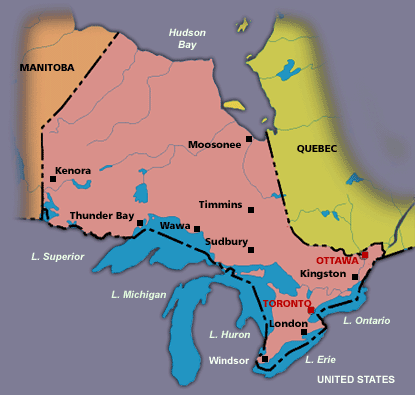Ontario
Pray:
- Pray for the Aglow groups and leaders to be strengthened.
- Pray for all the resources and creativity needed to fulfill the intentions of God in the province of Ontario.
- Pray for the Aglow prayer group in the Capital city.
- Pray for godly government leaders. Blessed is the nation whose God is The Lord, the people whom He has chosen for His own inheritance. Psalm 33:12
Proclaim:
- Arise, shine; for your light has come! And the glory of the LORD is risen upon you. For behold, the darkness shall cover the earth, and deep darkness the people; but the LORD will arise over you, and His glory will be seen upon you. Isaiah 60:1,2 (NKJV)
- Lift up your heads, O you gates! Lift up, you everlasting doors! And the King of glory shall come in. Who is this King of glory? The Lord of hosts, He is he King of glory. Psalm 24:9-10 (NKJV)
Interesting Facts About Ontario
Government: There are 103 seats in Ontario’s parliament (one for each riding), with riding boundaries following the same boundaries as those in the federal (Canadian) parliament. After a general election, the Lieutenant Governor asks the leader of the party with the most elected members to become Premier and form a government.
At least once every five years, Ontario holds a general election. During an election campaign, all parties normally run candidates in each of the province’s 103 constituencies. The candidate getting the most votes becomes the Member of Provincial Parliament (MPP) and represents the riding’s residents in the Provincial Legislature. Federally Ontario has 102 seats in the Canadian Parliament.
People: Ontario is the country’s most populated province. Over half of Ontario’s population lives along the western end of Lake Ontario between St. Catherines and Oshawa. Settlement and immigration from 1779 onward brought continuous waves of English, Scottish and Irish immigrants. Immigration continued throughout the twentieth century with large numbers of people of Italian, German, Chinese, Dutch, Portuguese, Indian, Polish and Caribbean origin arriving in the province. By the last decade of the twentieth century people from every country in the world lived in Ontario. English is the official language. Ontario’s Francophone population is the largest language minority
History: It is believed Ontario’s first peoples arrived about 10,000 years ago, during the last ice age. It is estimated that approximately four hundred years ago about 60,000 aboriginal people lived in what is today Ontario. They spoke one of two language groups; Algonquian and Iroquoian. The Algonquin speakers included the Ojibways, the Algonquins, and the Cree in the north and the Hurons, Tobaccos and Neutrals in the central and southern areas of present day Ontario.
The Algonquian-speaking people farmed, where soils permitted, but primarily they hunted and fished. The five Iroquoian-speaking nations lived most of the year in villages in the central and southern areas in what is present-day southern Ontario and northern New York where farming was more possible. Living in ‘longhouses’, surrounded by fortified walls, their towns were similar in nature to those of rural and agricultural peoples in parts of northern Europe.
Henry Hudson, after whom Hudson’s Bay was named, became the first European to touch the shores of present-day Ontario in 1610. During the conflict between the European powers for domination of global trade, both the French and the British claimed the newly discovered North American lands for their countries. France claimed what is now central Canada, calling it ‘New France.’ while the British in Hudson’s Bay and to the south, in present day United States, also laid claim to much of the land. New France included much of present day Ontario.
The French Governor Champlain established trading relations with the Hurons. In 1609 Champlain and his new Huron allies moved south into the territories of the Iroquoian peoples. In a short battle, at what is today Lake Champlain, guns were first used against the Iroquois. The French and the Huron initially defeated the Iroquois, however, this began a period of over 100 years of war in North America with both the colonial powers and the aboriginal people participating, and neither side winning.
The tribes north of Lake Ontario, the Hurons and the Neutrals, sided with the French, while the British supported those south of the lake. Eventually, the Iroquois successfully invaded the Huron settlements. The British conquered New France in 1759 with the Battle of the Plains of Abraham.
In 1763, King George III of England signed the Royal Proclamation of 1763 limiting white settlement in a large portion of ‘British’ North America, including part of western Quebec (present day Ontario). His proclamation attempted to control the activities of European fur traders and ensure treaties or “purchases” of land with the native peoples. After the American Revolution an influx of ‘United Empire Loyalist’ refugees moved into ‘British’ North America. The Aboriginal peoples signed treaties with the Crown, which turned over a great deal of the land in what is now southern Ontario.
Under the Constitutional Act of 1791, ‘Quebec’ was divided in two and Ontario renamed Upper Canada. In 1840, after the rebellions of Upper and Lower Canada were put down, an Act of Union saw Upper and Lower Canada reunited, this time with the name Canada. The two regions, Canada West and Canada East, took part in the 1864 Confederation debate and, when the British North America Act (BNA) of 1867 created the Dominion of Canada they became the new Canadian provinces of Quebec and Ontario.
Interesting Facts information from the library.educationworld.net/canadafacts website. Read more about Ontario


